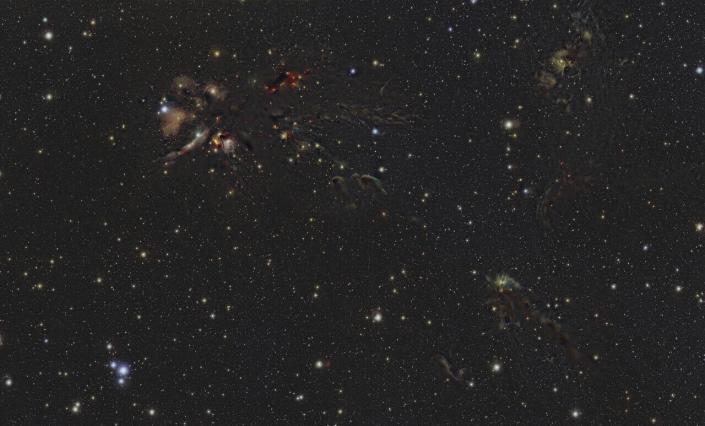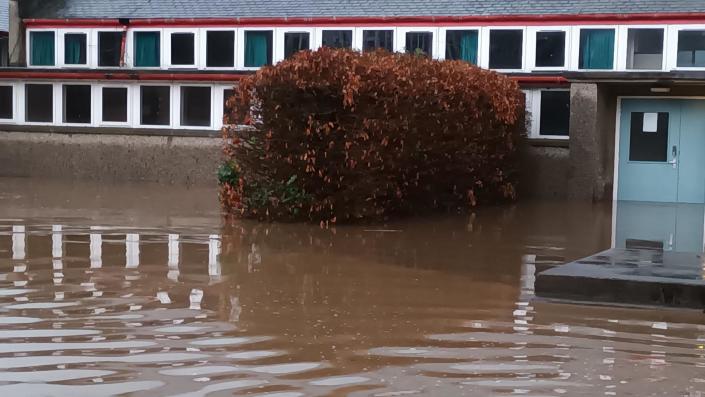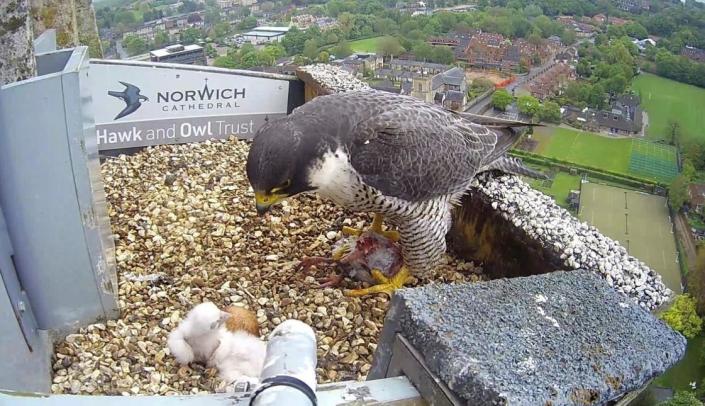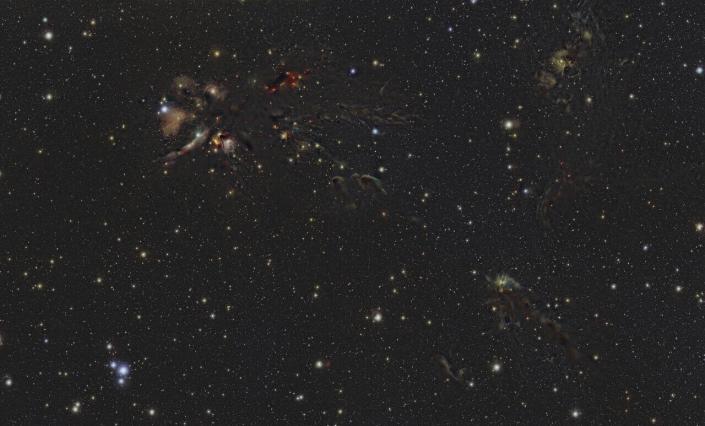Science Daily News | 12 May 2023

Views (175)

School flood damage costs 'in the hundreds of thousands'
Sewers in Bellingham village in Northumberland were overwhelmed during downpours on Saturday night.

A rural school is facing a repair bill of hundreds of thousands of pounds after flash flooding during the weekend.
Sewers in the village of Bellingham, Northumberland were overwhelmed during downpours on Saturday night.
The water caused extensive damage to the shared Bellingham Primary and Middle school site, requiring a large clean-up by teachers, parents and pupils.
School governor and parent Ant Kirkbride said when he was called out to the site he found “catastrophic” damage.
“I came up to the school and was met with a torrent of water,” he said.
“The water smashed through the gates, the doors, the boiler room."
Northumberland County Council, which maintains the school, said it was “committed both practically and financially to getting pupils back on to their current school site as soon as possible".
Mr Kirkbride said they had been quoted more than £200,000 to repair the boiler room alone.
“All of the carpets will need replacing," he said.
"We’ve got silt throughout the school."
Loss adjusters have visited the site but the full cost of repairs and clean-up is not yet known.
Mr Kirkbride said the flood was the latest in a series of events which had disrupted pupils’ teaching time.
It follows school closures during the pandemic and Storm Arwen, and happened the weekend before Year Six pupils were due to sit their Sats tests, which they are now having to take at a nearby community hall.
Bellingham Middle School interim head teacher Dan Ramshaw said three year groups had to learn remotely.
"Next week we’re hoping to use more local spaces to teach children,” he said.
Mr Kirkbride said pupils "were visibly upset” when they came to help clean up.
“Their classrooms were completely washed out," he said.
“Their school which they love and come to every day was completely and utterly written off.”
His six-year-old son, William, one of about 60 pupils at Bellingham Primary School, was unhappy "because we don’t get to see our friends and do lessons”, he added.
The council reassured parents the flooding would not lead to the school's permanent closure.
It said it was supporting school leaders and governors "to arrange appropriate interim provision where face to face teaching can continue".
Composting at home could save island money, States says
More than 3,500 tonnes of separate food waste was collected in 2022.

A new campaign to encourage islanders to home compost has been launched.
Guernsey Waste said it aimed to "encourage more islanders to take up home composting".
The company said food waste was being collected and exported "at a cost which could be dealt with on island for free".
The States said more than 3,500 tonnes of separate food waste was collected from households in 2022, equating to about 130kg (20st 4lb) per home.
It said more than a third of food waste could be composted at home, such as raw fruit and vegetables, coffee grounds and salad.
Waste prevention and recycling officer Tina Norman-Ross said the cost of managing the material would reduce if more families composted at home.
She said: “Whether this is using a compost bins, building your own heap, creating a wormery, buying a hot bin, or even a bokashi - there are lots of ways to compost to suit the size of your garden.
“The more food waste we compost at home, the less we have to export and the less we all have to pay to process it.”
9 useless body parts that humans no longer need
Humans' appendix, tail bone, and other organs no longer serve a purpose. Our wisdom teeth also became useless after we began eating softer foods.

Some human body parts have become useless over the past few million years.
Useless body parts include the appendix, the tail bone, and the muscle fibers that produce goose bumps.
Take a look at nine body parts that remained in the human body despite having no function for millions of years.
Some human body parts serve no purpose despite once having a specific function among our ancestors.
Several other body parts used to be important for humans' survival, but they have since become useless. Some of them can be removed, and the absence of them does not lower people's quality of life.
Take a look at nine body parts that remained in the human body despite having no function for millions of years.
The appendix may be the most commonly known useless organ.
"As we started switching to a more diverse diet and targeting meat, we didn't need super long and complicated intestinal tracts anymore," Amir told Business Insider.
However, there is increasing evidence that the appendix does store some useful gut bacteria, but it is unclear if "this was always its function for us, or whether this was an old dog learning new tricks," she said.
The palmaris longus muscle runs from the wrist to the elbow. About 10% of humans do not have it.
"It's been a while since it was useful," Amir said.
Now, however, someone's grip strength is the same whether or not they have the muscle. "Natural selection is not a system geared toward perfect efficiency," Amir said.
Humans no longer need very powerful jaws because our diets have shifted toward soft foods and cooked grains. Our jaws are also smaller, so we can't all fit in our wisdom teeth properly.
"Given that we eat pretty soft food now, and molars are usually used for grinding, we don’t really need them anymore," Amir said.
Arrector pili are muscle fibers that produce goose bumps when they contract. Our ancestors, who had a lot more body hair, used these fibers to their advantage, but we don't have a use for them anymore.
For animals with thick fur, arrector pili can help provide insulation. The fibers can also make animals look bigger — a porcupine benefits from this phenomenon.
Human embryos develop a tail between five and eight weeks after conception. The tail vanishes by the time humans are born, and the remaining vertebrae merge to form the coccyx, or tailbone.
Tailbones helped our ancestors with mobility and balance, but the tail shrank as humans learned to walk upright. The coccyx now serves no purpose in humans.
"Our ancestors who had mutations that got rid of the tail seemed to fare better, and thus our tails went away over many generations," Amir told Business Insider.
Auricular muscles control the visible part of the ear, but humans have lost the ability to use them. Other mammals use these muscles to detect prey and predators.
Some humans can wiggle their ears, but that's the best we can do.
The pyramidalis muscle, which is located in the lower abdomen, is shaped like a triangle. People have from zero to two of these muscles, but they don't help us.
About 20% of humans do not have any pyramidalis muscles.
Male and female fetuses initially develop the same way, and testosterone triggers the formation of male sex organs later on. Before these hormones kick in, however, nipples have already begun to develop.
While many male mammals could lactate under extreme scenarios, only the Dayak fruit bat, found in Southeast Asia, lactates spontaneously, according to Scientific American.
The plica semilunaris, or third eyelid, is a fold of tissue found on the inside corner of the eye. It resembles membranes that some animals use to protect their eyes.
Birds, reptiles, and some mammals can pull these membranes across their eyes to keep them moist and free of debris.
"It's not exactly clear why humans don't have these anymore," Amir said, "but they're actually rare among primates so we must have lost them a long time ago."
This story was originally published in January 2019.
Here's what the color of your snot really means
Boogers can tell you quite a lot about the state of your health. Here's what the color of your snot says about you, in one simple table.

Though it may be offputting, mucus is a vital part of the body's protection.
The color of your boogers can help you figure out what's going on in your body.
Here's what the color of your snot means, in one simple table.
Very few people talk about these things, but let's break that taboo.
The mucus in your nose serves many functions. Its color can tell you and your doctor a lot about what's going on in your body — especially when it's been an abnormal shade for a long time.
You should know that snot color is not enough to diagnose anything outright.
Still, it offers a unique glimpse into your body's strange ways of telling you that something's up.
Clear mucus is totally normal. The body naturally produces a lot of mucus
Snot is a mixture of protective proteins and salts, with water. It keeps your nasal passages lubricated and germ-free by acting as a moisturizing barrier against dehydration and foreign objects, including bacteria and viruses.
Having a little clear mucus in the nose is nothing to be worried about. But if the amount drastically increases, it could mean that you're suffering from allergies or the start of a cold or flu.
White mucus could mean a bunch of different things.
Most often it means that your nasal passages are irritated and swollen, restricting mucus flow and causing it to dry out.
This could also be due to a nasal infection, allergies, or dehydration.
After they've done their job and die, the white cells are flushed out of your body with your mucus, and in the process can dye it yellow.
Yellow mucus doesn't mean that you need antibiotics — the body faces infections all the time and is very good at fighting them off.
An infection could also be caused by a virus, in which case the antibiotics would be useless.
At this point, you may want to wait it out and see if things improve over the coming week or so.
Your mucus can also turn green from a large build-up of dead white blood cells.
If your mucus has been green for a few weeks or longer, you should see your doctor; especially if you have a fever or feel nauseated.
Red or pink mucus means there's some blood in your nose.
This results from any number of things, including allergies, infection, and lots of blowing or rubbing. Physical trauma — like walking into a wall face-first — can also turn your snot red.
But brown mucus isn't always because of blood. It could also be caused by dirt, dust, discoloration from cigarette smoke, snuff, or a spice.
If you're coughing up brown mucus, though, you should see a doctor because this could be a sign of bronchitis.
It can also be due to inhaling dirt or dust; or after smoking cigarettes or marijuana.
If your mucus is black for no obvious reason, you should see a doctor. This is especially true if you have a fever, chills, or have difficulty breathing.
This article was first published on Jan 1, 2016. Julia Calderone contributed to the previous version of this article.
Falcon webcam switched off after death of chicks
Experts confirm the death of two chicks that recently hatched at Norwich Cathedral.

Two peregrine falcon chicks that hatched earlier this month in a nest at Norwich Cathedral have died.
The Hawk and Owl Trust, which manages the nesting site 75m (246ft) above ground on the tower, said the cause of their deaths was not known.
It also said a third egg which had not yet hatched was unlikely to do so as it was beyond the expected hatching date.
A live webcam trained on the nest box has been turned off.
There was speculation one of the two chicks was not feeding.
In a statement, the trust said it had informed the Department for Environment, Food and Rural Affairs and would not speculate about the cause of death.
Wildlife photographer Chris Skipper, who has been monitoring the peregrines for years, said it was "very strange to lose two in such a short space of time".
"There's a lot of bird flu in Norfolk, but it would be strange if the parents were not affected as well," said Mr Skipper.
He also said it was possible the chicks were wet or cold during the recent bad weather, despite the nest box having drainage holes.
"This happens every day in nature," Mr Skipper said.
"But because we are so close to them - because it's all on camera - it really does bring it home to you."
Stunning mosaic of baby star clusters created from 1 million telescope shots
Astronomers have created a stunning mosaic of baby star clusters hiding in our galactic backyard. To come up with their atlas, scientists pieced together more than 1 million images taken over five years by the European Southern Observatory in Chile. "We can detect even the faintest sources of light, like stars far less massive than the sun, revealing objects that no one has ever seen before,” University of Vienna's Stefan Meingast, the lead author, said in a statement.

CAPE CANAVERAL, Fla. (AP) — Astronomers have created a stunning mosaic of baby star clusters hiding in our galactic backyard.
The montage, published Thursday, reveals five vast stellar nurseries less than 1,500 light-years away. A light-year is nearly 6 trillion miles (9.7 trillion kilometers).
To come up with their atlas, scientists pieced together more than 1 million images taken over five years by the European Southern Observatory in Chile. The observatory’s infrared survey telescope was able to peer through clouds of dust and discern infant stars.
"We can detect even the faintest sources of light, like stars far less massive than the sun, revealing objects that no one has ever seen before,” University of Vienna's Stefan Meingast, the lead author, said in a statement.
The observations, conducted from 2017 to 2022, will help researchers better understand how stars evolve from dust, Meingast said.
The findings, appearing in the journal Astronomy and Astrophysics, complement observations by the European Space Agency's star-mapping Gaia spacecraft, orbiting nearly 1 million miles (1.5 million kilometers) away.
Gaia focuses on optical light, missing most of the objects obscured by cosmic dust, the researchers said.
___
The Associated Press Health and Science Department receives support from the Howard Hughes Medical Institute’s Science and Educational Media Group. The AP is solely responsible for all content.
0 Likes
